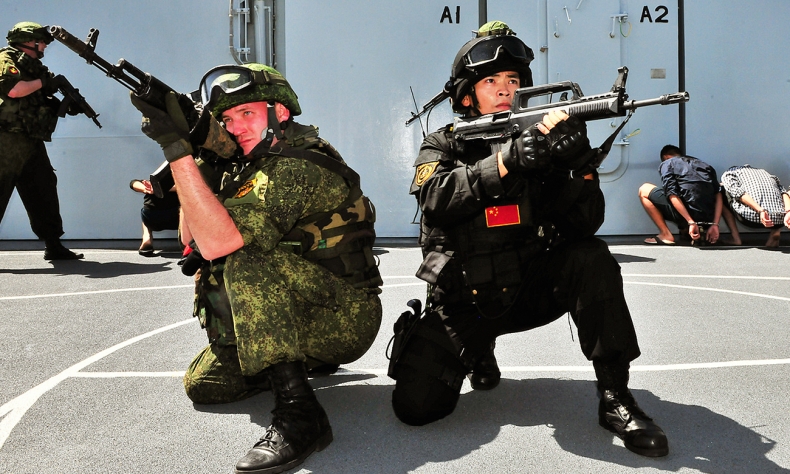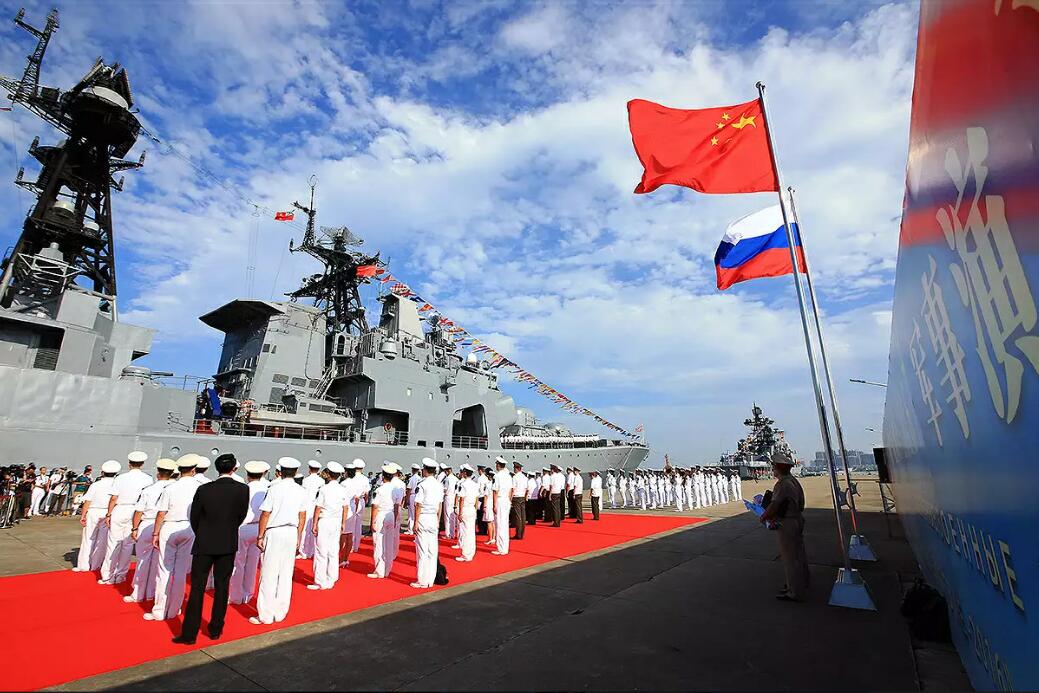China-Russia Unprecedented Joint Military Exercises

These are the largest military exercises since 1981, and the largest since the establishment of the Russian Federation.
Chinese Ministry of Defense recently confirmed that Chinese armed forces will head for Russia to participate in the Vostok-2018 military exercises.
According to Russian Minister of Defense Sergey Shoygu, the joint exercises will last from September 11 to 15, with armed forces from China and Mongolia taking part. The level of territorial scope—stretching across the Far East and Siberia—and other criteria, including the command service and participating troops, are all unprecedented, Shoygu emphasized.
The military exercises will be hosted in the Eastern and Middle theatres of Russia. The Russian Northern Fleet, the airborne armed forces and long-distance military transport aircrafts will be part of the exercises. A spokesperson for the Kremlin also confirmed that Russian President Vladimir Putin will attend the exercises.
These are the largest military exercises since 1981, and the largest since the establishment of the Russian Federation. Vostok, Zapad, Tsentr and Caucasus are the names of large-scale military exercises that have taken place since the end of the Soviet Union. These military exercises all point in key strategic directions and simulate the scale of real strategic battles.
The Zapad-81 military exercises were held by the Soviet Union in 1981 during the peak of Soviet-U.S. confrontation. The exercises, which aimed at displaying Russian military might, summoned up more than 150,000 soldiers, including integrated group armed forces, air force troops, the Baltic Fleet and the Strategic Rocket Forces. These exercises were regarded as the biggest military exercises in human history.
During the present sensitive period, when Russia-U.S. relations are still at a standoff and China-U.S. friction is escalating, what signal does China’s participation in the Vostok-2018 military exercises convey?
China’s Armed Forces “Going Out”
About 3,200 Chinese soldiers and over 900 pieces of weapons, 30 fixed-wing combat aircrafts and helicopters will partake in the exercises, including mobile defense, fire strike and counterattack. In contrast to former joint military exercises with Russia, this is the first time China participates in such a large-scale military exercise at a strategic level hosted by Russia. In addition, the number of soldiers participating in exercises outside of China’s territory is the largest in Chinese history.
China’s Ministry of Defense highlighted that these military exercises aim to consolidate the development of the China-Russia comprehensive strategic partnership of coordination, deepen practical and amicable cooperation between the two armed forces, and further strengthen the capacity of the two armed forces to jointly tackle all kinds of security threats. The military exercises are beneficial for upholding regional peace and security and do not target any third party.
Moreover, the Shanghai Cooperation Organization’s (SCO) Peace Mission 2018 joint military drill is also being held in Russia from August 22 to 29. Seven countries—China, Russia, Kazakhstan,Tajikistan, Kyrghyzstan, India, Pakistan, with more than 3,000 soldiers—are participating in the drill in Chebarkul, Chelyabinsk. Uzbekistan attended the drill as an observer. The theme of the drill is fighting terrorism, insurgency and extremism. This is the first time Indian takes part in an SCO drill and the first time Indian and Pakistani soldiers take part in the drill together. Although the scale of the drill is not large, it still plays a positive role in promoting cooperation and mutual trust among SCO members.
Strategic mutual trust Advanced
China’s participation represents the fact that strategic mutual trust and cooperation between China and Russia have reached a new level. The two countries have enhanced cooperation in major security fields in recent years. Strategic coordination and mutual trust have been constantly strengthened.
Δ Russian naval forces receive a full diplomatic welcome after arriving in Zhanjiang before kicking off Joint Sea 2016.
Last year, for example, the Chinese and Russian navies held joint military exercises on the South China and Baltic seas based on their respective strategic directions. Russia awarded Chinese President Xi Jinping the highest order of the Russian Federation, the Order of St. Andrew the Apostle the First-Called, in 2017, and this year, Xi awarded Putin China’s first Friendship Medal. These actions show that the China-Russia comprehensive strategic partnership of coordination has continued to deepen in practical terms.
The high level of consensus between the two countries on key issues such as international politics, the future world pattern and changes in international systems, have contributed to the formation of the present trend of China-Russia relations.
The United States has always deemed Russia a rival and currently regards China as a strategic competitor. To broaden the strategic space between China and Russia, the United States keeps consolidating and expanding its military alliances formed during the Cold War in Eurasia and enhancing highly invasive military deployments.
These actions threaten the national security and territorial integrity of China and Russia. Further development of China-Russia relations needs to enhance the capacity of resisting external threats to both countries, with the crucial goal of confronting strategic containment and military threats from the United States.
China’s participation will also display the preliminary results of China’s military reform in the new era. China has reconstructed the framework of its command system and optimized the scale and structure of its armed forces. It has reformed the organization of combat forces and developed new ones.
Notwithstanding that reform is still in progress, China’s armed forces have already taken on a new look. During the military reform, some parts of former divisions and brigades have significantly upgraded their firepower capacity, defense and mobility through reconstruction. They have been dismantled and reorganized as new integrated divisions that are equipped with unstaffed aerial vehicles, command systems and digital communication systems. In addition, Russian military exercises are famous for being large-scale, high-intensity and fast-paced.
By participating in this type of military exercises, China’s armed force will need to access higher standards of frontline command service and coordination with their Russian counterparts. It is also a good opportunity to examine the capacity of cooperative combat by multiple armed forces.
“Going out” manifests China’s military confidence
In former joint military exercises with other countries, China’s armed forces have exposed several disadvantages in their training level, combat capacity and military ideology when compared with the world first class armed forces. In recent years, China’s armed forces have strengthened their combat capacity with the goal of winning modern wars under informatized conditions. All armed forces have put great emphasis on competitive training. Xi, who is also Chairman of the Chinese Central Military Commission, issued a training order to all armed forces at the beginning of the year. The participation of China’s armed forces in Vostok-2018 shows the growing confidence of China’s armed forces.
China’s participation in the Russian military exercises manifests that China-Russia strategic cooperation has been consistently improving, with continuous enhancing in military capacities and strategic consensus, including jointly resisting external military threats and safeguarding national security. Some Western media tend to take China’s participation in foreign military exercises as evidence of China’s so-called “military threat.” However, the United States continues to promote the so-called “freedom of navigation” in the South China Sea, refuses to allow China to participate in the Rim of the Pacific Exercise, publishes strategic guidelines that are hostile to China, and has been on the brink of stepping on the red line of One China policy in recent years. If one examines U.S. actions, it is easy to see who is the actual threat.
China-Russia joint military exercises do not target any third party, but instead are aimed at every possible military threat from formidable foes in the future.
By Hu Xin, associate professor of Institute of Strategic and Security Studies, School of International Studies, National University of Defense Technology
Editor: Elena
 Facebook
Facebook
 Twitter
Twitter
 Linkedin
Linkedin
 Google +
Google +





